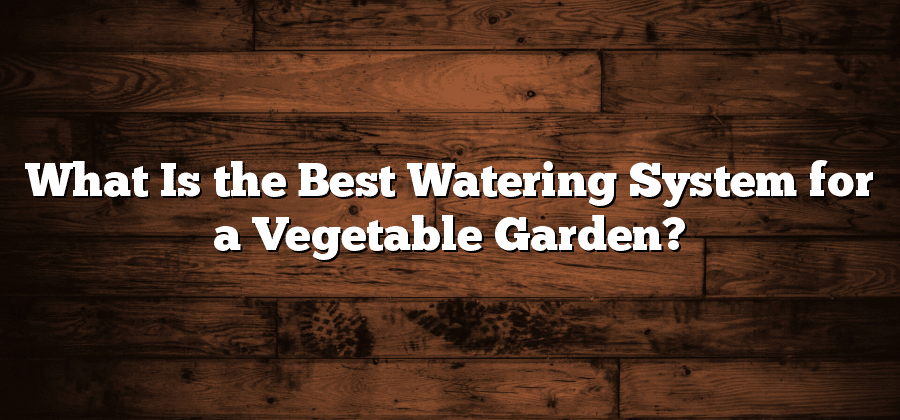Drip Irrigation Systems for Efficient Watering
One of the most efficient methods of watering plants is through the use of drip irrigation systems. This system delivers water directly to the plant’s roots, reducing water waste and improving overall efficiency. With drip irrigation, water is released slowly and evenly, allowing plants to absorb moisture effectively. This method minimizes evaporation and ensures that water reaches the intended target without any unnecessary runoff. Drip irrigation systems are popular among gardeners and farmers alike, as they promote healthy plant growth while conserving water resources.
In addition to improved efficiency, drip irrigation systems offer other advantages. They can be easily customized to meet the specific needs of different plants and soil types, ensuring optimal moisture levels at all times. This level of control also helps prevent diseases and root rot, as the foliage remains dry during the watering process. Moreover, using a drip irrigation system eliminates the need for hand-watering or cumbersome sprinklers, saving both time and effort for the gardener. Overall, this method of watering is not only highly efficient but also provides a convenient and effective solution for plant care.
Sprinkler Systems for Wide Coverage
One of the most popular options for watering larger areas is the use of sprinkler systems. These systems are designed to provide wide coverage, making it convenient to water large lawns, gardens, and agricultural fields. Sprinklers work by distributing water in a circular or semi-circular pattern, ensuring that the entire area receives adequate hydration.
Sprinkler systems are known for their efficiency and ease of use. They can be set to operate on a timer, allowing for automated watering that saves time and effort. Additionally, many modern sprinkler systems come with adjustable settings, allowing users to customize the water flow and coverage based on specific needs. This flexibility makes sprinkler systems suitable for a variety of landscapes and watering requirements. However, it is essential to choose the right type of sprinkler system and ensure proper maintenance to prevent water waste and maximize efficiency.
Soaker Hoses to Minimize Evaporation
Soaker hoses are a highly effective and efficient method for minimizing water evaporation when it comes to watering your garden or landscape. These hoses are designed with tiny perforations along their length, allowing water to seep slowly and directly into the soil. By delivering water directly to the roots of your plants, soaker hoses minimize surface evaporation, ensuring that every drop of water goes exactly where it is needed.
One of the main advantages of soaker hoses is their ability to provide consistent and even watering throughout the entire area of your garden. Unlike sprinkler systems that can result in uneven water distribution, soaker hoses deliver water in a gentle and steady manner. This not only saves water by minimizing evaporation but also ensures that all plants receive an adequate amount of moisture for proper growth and development. Moreover, the slow and gradual water release of soaker hoses allows the soil to absorb the water more effectively, reducing runoff and promoting better water penetration for healthier root systems.
Rainwater Harvesting for Sustainable Watering
Rainwater harvesting is an eco-friendly method of collecting and storing rainwater for various purposes, including sustainable watering. By utilizing this technique, homeowners and businesses can reduce their reliance on municipal water supplies and contribute to water conservation efforts.
One of the main advantages of rainwater harvesting is its ability to provide a sustainable and cost-effective solution for watering plants, gardens, and lawns. With proper collection and storage systems in place, rainwater can supply an ample amount of water throughout the year, especially in regions where water scarcity is a concern. Additionally, rainwater is free from chemicals and additives typically found in tap water, making it a healthier option for both plants and the environment.
Furthermore, rainwater harvesting promotes self-sufficiency and resilience in water management. By capturing rainwater during periods of heavy rainfall, homeowners can create a buffer supply that can be used during dry spells or water restrictions. This makes rainwater harvesting an ideal choice for those who want to maintain vibrant landscapes without relying solely on municipal water sources.
Self-Watering Containers for Convenience
Self-Watering Containers for Convenience
One innovative solution for hassle-free watering is the use of self-watering containers. These containers incorporate a reservoir system that allows plants to draw water as needed, reducing the frequency and effort required for manual watering. With self-watering containers, busy gardeners can have peace of mind knowing that their plants will receive a consistent water supply, even during periods of absence or forgetfulness.
The self-watering containers operate on a simple principle. They consist of two compartments – a water reservoir and a planting area. The water reservoir is located at the bottom of the container and is separated from the planting area by a wicking material, such as a fabric or rope. As the plants in the container consume water, the wicking material draws water from the reservoir, delivering it to the root zone. This efficient system not only saves water but also prevents overwatering, as the plants can access only the required amount of moisture.






